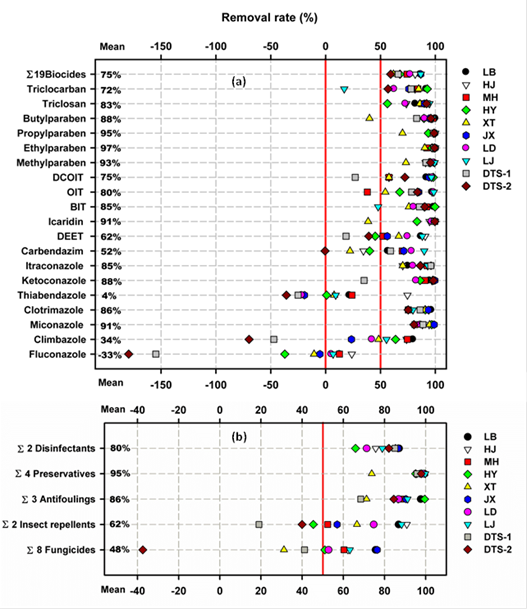Perfluoroalkyl substances (PFASs): Perfluoroalkyl substances (PFASs) are a group of chemicals with wide industrial and commercial applications, and have been received great attentions due to their persistence in the environment. The information about their presence in urban water cycle is still limited. This study aimed to investigate the occurrence and removal efficiency of eighteen PFASs in wastewater treatment plants (WWTPs) and drinking water plants (DWTPs) with different treatment processes. The results showed that both perfluorobutane sulfonic acid (PFBS) and perfluorooctane sulfonic acid (PFOS) were the predominant compounds in the water phase of WWTPs and DWTPs, while PFOS was dominant in dewatered sludge of WWTPs. The average total PFASs concentrations in the three selected WWTPs were 19.6-232 ng/L in influents, 15.5-234 ng/L in effluents, and 31.5-49.1 ng/g dry weight in sludge. The distribution pattern of PFASs differed between the wastewater and sludge samples, indicating strong partition of PFASs with long carbon chains to sludge. In the WWTPs, most PFASs were not eliminated efficiently in conventional activated sludge treatment, while the membrane bio-reactor (MBR) and Unitank removed approximately 50% of long chain (C≥8) perfluorocarboxylic acids (PFCAs). The daily mass loads of total PFASs in WWTPs were in the range of 1956-24773 mg in influent and 1548-25085 mg in effluent. PFASs were found at higher concentrations in the wastewater from plant A with some industrial wastewater input than from the other two plants (plant B and plant C) with mainly domestic wastewater sources. Meanwhile, the average total PFASs concentrations in the two selected DWTPs were detected at 4.74-14.3 ng/L in the influent and 3.34-13.9 ng/L in the effluent. In DWTPs, only granular activated carbon (GAC) and powder activated carbon (PAC) showed significant removal of PFASs. The PFASs detected in the tap water would not pose immediate health risks in the short term exposure. The findings from this study showed that effective treatment technology should be applied to eliminate this group of chemicals in the urban water cycle based on the precautionary principle.
Biocides: In recent years, biocides as emerging organic contaminants have received increasing attention due to their wide uses, frequent detection and designed biocidal properties. Various biocides are prevailingly used in all kinds of pharmaceuticals and personal care products (PPCPs). After use of these products, a mass of biocides were discharged into wastewater and then reached wastewater treatment plants (WWTPs) through sewer network. Generally, almost all of biocides cannot be removed completely by conventional treatment technologies, thus these chemicals were released into the receiving rivers through WWTP effluent discharge. But those biocides present in the aquatic environment may cause some adverse effects on aquatic organisms even human beings, such as acute/chronic toxicity, bioaccumulation and endocrine disrupting effects. In present China, however, limited studies have been done to investigate the occurrence, fate and ecological risk of biocides in different WWTPs and the receiving rivers. Therefore, we systematically investigated the occurrence, removal and pollution loads of 19 biocides in ten WWTPs of Guangdong province, South China.
The concentration levels of 19 biocides in WWTPs and their receiving rivers were investigated by using an ultra-high performance liquid chromatograph coupled to a triple quadrupole mass spectrometer (UHPLC-MS/MS), and then we studied their removals and pollution loads of 19 biocides indifferent treatment stages of WWTPs with mass balance analysis approach. The results showed that all the target biocides were universally detected in the WWTPs and their receiving rivers, and 19 for liquid samples and 18 for solid samples. The highest concentrations were found for N, N-diethyl-3-methylbenzamide (DEET) in wastewater (mean: 110~393 ng/L) and triclocarban in sludge (mean: 1170~2110 ng/g). Meanwhile, DEET and triclocarban also showed the highest levels among the 19 biocides in the receiving water (mean: 235 ng/L) and sediment (mean: 339 ng/g, dry weight). Most biocides were readily removed from the liquid phase of ten WWTPs, and the mean removal rate to ∑19 biocides was up to 75%. The treatment technologies of modified A/O (Anaerobic-Oxic), MBR (Membrane Bio-Reactor) and Carrousel 2000 oxidation ditch showed excellent removal efficiencies (≥82%) for total biocides. The removals of target biocides were attributed to biodegradation and adsorption onto activated sludge. The mean input per capita for ∑19 biocides based on influent concnetrations was 907μg/d/person, while the emissions per capita were 187 μg/d/person for effluent, and 121μg/d/person for excess sludge. On the whole, the total back-estimated usage of ∑19Biocides was up to 453 t/y in the whole China, and the total estimated emission of ∑19Biocides discharged to the receiving environment through effluent and excess sludge was also up to 289 t/y. As demonstrated, discharge of wastewater led to the contamination of the receiving rivers by these biocides, some of which could pose high ecological risks to aquatic organisms, such as clotrimazole, carbendazim, and triclocarban. Therefore, advanced wastewater treatment technologies should be developed to reduce the emission of biocides into the receiving environment, and further to minimize their potential risks to the ecological environment and even human beings.

Figure 13. Removal rates (%) of biocides in municipal wastewater treatment plants.
References:
(1) Pan CG, Liu YS, Ying GG (2016) Perfluoroalkyl substances (PFASs) in wastewater treatment plants and drinking water treatment plants: Removal efficiency and exposure risk. Water Research 106, 562-570.
(2) Liu WR, Yang YY, Liu YS, Zhang LJ, Zhao JL, Zhang QQ, Zhang M, Zhang JN, Jiang YX, Ying GG (2017) Biocides in wastewater treatment plants: mass balance analysis and pollution load estimation. Journal of Hazardous Materials 329, 310-320.